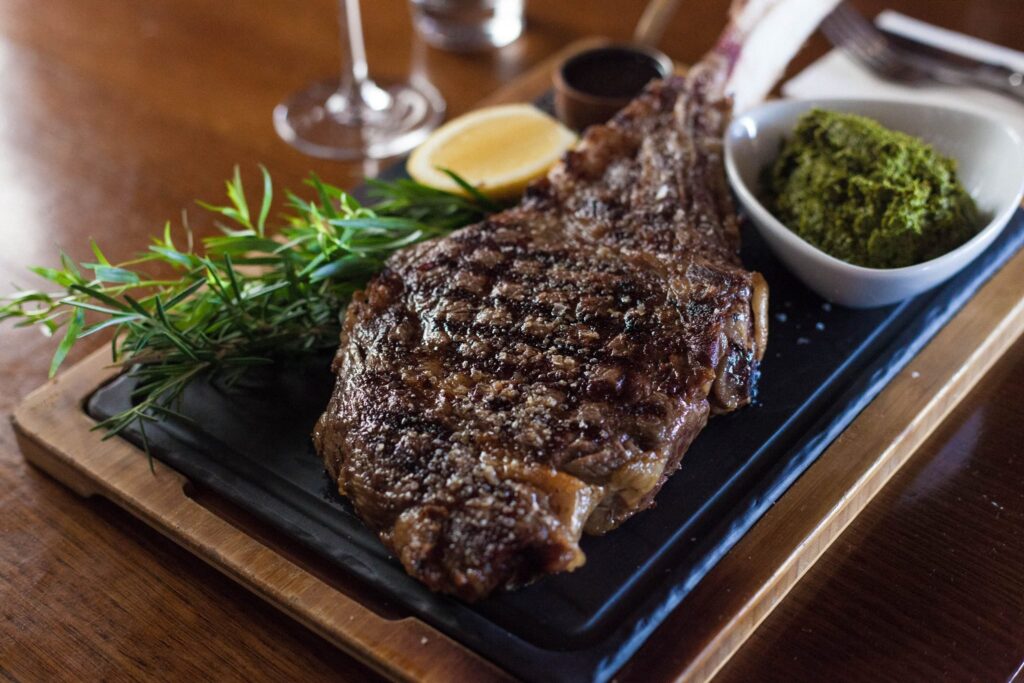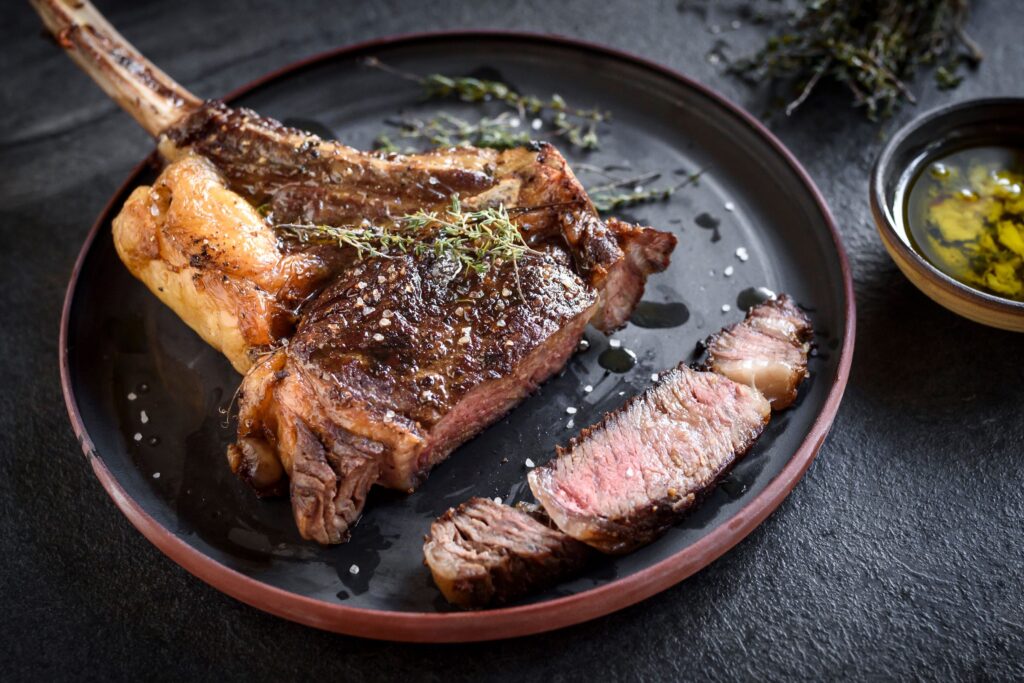There are several methods to cook a steak, including directly over coals, searing it till done, and even sous vide, yes, boiling a steak is a thing these days.
The reverse sear is, in my opinion, the ideal technique to cook a beautiful thick Tomahawk ribeye steak.
By gradually raising the internal temperature, we get absolutely equal doneness throughout the steak, and then we sear it to produce a crust on the exterior for added taste and texture.
Eat the steak alone, holding it by the bone like a caveman, or slice it up and serve with grilled asparagus and mushrooms on the side.
Contents
- Why the reverse sear is the best way to cook a thick steak
- Choosing the correct steak
- How to flavor your steak
- How to season your steak
- Setting up the grill for dual zone cooking
- Managing the cook
- Steak serving suggestions
- FAQs
- How long to grill reverse sear tomahawk steak?
- Is reverse sear better for a tomahawk steak?
- Can you reverse sear tomahawk steak in the oven then grill?
- What is the best grill temp for reverse sear steak?
- What temperature do you reverse sear tomahawk steaks?
- Do you salt steak before reverse sear?
- Why do you put foil on a tomahawk steak?
- Do you flip a steak when reverse searing?
- What is the best way to cook a tomahawk steak?
Why the reverse sear is the best way to cook a thick steak

The reverse sear technique is unbeatable for home cooking a thick steak. It produces flawless results every time, regardless of the cut of steak or the grill utilized.
Just make sure you’re cooking a big steak (at least 1 2 inches thick), since it doesn’t work well on smaller steaks.
Rather of relying on guessing, you cook the steak low and slow, gradually bringing it up to 15 degrees below your target done temperature, then taking it off the heat and wrapping it in foil.For additional information, see our guide to steak doneness.
What I mean by holding the temperature is that we are not resting it since a reverse seared steak does not need resting because the internal temperature has been gently elevated. You just need to make your grill or pan as hot as possible and then sear it on all sides till you have a beautiful steak every time.
I understand there are numerous ways to cook a steak and you may get wonderful results using other techniques, but I believe this is the greatest approach I’ve found to cook the ideal steak every time.
Items that will help you cook these are:
- A hooded grill capable of dual zone cooking (I’m using a 22 Weber Kettle)
- Lump charcoal
- Rub shaker
- Boning or trimming knife
- I’m using a ThermoWorks Thermapen ONE instant read thermometer.
- Grill grates or cast iron pan
Choosing the correct steak

Unfortunately, the reverse sear process is not suitable for all steak sizes. It works well with steaks sliced thicker than 1.5 inches. However, if you prepare a huge, high-quality steak like that, you can always serve it as a little roast.
The thickness of the steak is required for the internal temperature to increase steadily. This helps the steak cook more evenly and provides for more precise control, allowing you to remove the steak precisely when required.
As long as you keep an eye on it, you will never have overdone meat again.
Because the interior temperature rises at a slower pace than if you seared your steak from the start, you have the precise control of being able to remove it from the fire at the precise moment required.
So any cut of steak will work for the reverse sear procedure, as long as it is thicker than one and a half inches.
When it comes to steaks, my go-to size is 2 thick. Not only is it a delicious meal, but it also cooks up beautifully on the grill.
Ribeye or sirloin are both excellent choices. In this instance, I chose the tomahawk, which doesn’t offer much taste but looks great, and there’s some evidence that the bone protects the flesh and keeps it from cooking too rapidly.
How to flavor your steak
How much is too much is an age-old issue. I believe a lot of folks now days see pictures of people coating their steaks with three different rubs after salting them for hours. They had no idea they are seeing someone’s preparation for a steak cooking competition.
This is where the tastes must be amplified since each judge will only receive one mouthful of your steak, so the flavors must be packed in. There is no way you could eat a full steak prepared and grilled for a steak competition without feeling nauseous afterwards.
So, where are we going to draw the line? Some people believe that a delicious steak requires no seasoning, while others believe that salt and pepper are the best method to season a steak. At the end of the day, the individual consuming it determines what is required.
On my steaks, I enjoy the traditional SPG of salt flakes, roughly powdered black pepper, and granulated garlic. These three ingredients are about the same size, and I put an equal amount of each on my steaks.
How to season your steak
Didn’t we just talk about how to season your steak? No, seasoning begins far earlier than most people believe, and taste is what is in that seasoning.
If you have the time, season the steak the day before by placing it on a wire rack on a tray and seasoning both sides equally before placing it in the fridge uncovered. The dry brining method will assist to dry out the outside of the steak, and the drier it is, the better the sear.
The salt will also take out moisture, which will then be dissolved, and the steak will suck that moisture back in, tenderizing and flavoring the steak overnight.
I never manage to plan ahead these days, so I take the steak out of the fridge and season it an hour or two before cooking. This provides the salt and meat ample time to work their magic.
Setting up the grill for dual zone cooking
For this cook, I’m using a 22 Weber kettle that I’ve built up for dual zone cooking by igniting a roughly half-full chimney starter with lump charcoal.
When the coals are completely white, I’ll move them to one side of the cooking grate and add a few more bits of unlit charcoal.
I’ll replace the grill and close the lid. For the low and slow part of the cook, I’m looking for a temperature of 200F to 250F.
I’ll set the steak on the other side of the grill to the ignited fire when it’s warmed up for five minutes, and I’ll also add a bit of cherry wood for some additional smokey flavor.
I’ll also warm up my Grill Grates by placing them upside down over the lump charcoal. This isn’t necessary; I simply appreciate how my grill grates prevent flare-ups; you could get the same result with a cast iron pan.
Managing the cook
I’ll replace the cover, keeping the lid vent directly over the steak. The heat and smoke will be drawn over the meat as a result of this.
My goal temperature is 15 degrees below what I want the steak to finish at; I want a medium-rare steak at 130 degrees, so I will remove the meat at 115 degrees; this will take around an hour, depending on the thickness of the steak and how hot your grill is.
As the internal temperature of the steak approaches 100 degrees Fahrenheit, I’ll ignite a chimney starter filled of high heat charcoal briquettes, which burn hotter and more reliably.
This is when I’ll add my garlic butter mushrooms, which I’ve prepared on a tray with melted butter, garlic, thyme, balsamic vinegar, salt, and pepper. I’ll keep them in the cooler zone of the grill until the steak is thoroughly cooked.
When the steak reaches 115°F, I’ll remove it from the pan and wrap it in foil with a glob of butter. I’m not attempting to or needing to rest the steak (we explain why in our guide to steak myths).
Because I gradually increased the internal temperature, there is no need or advantage to resting the beef as you would when cooking a steak the usual hot and quick technique. I’m only maintaining the temperature so I can add more fuel and warm up the grill grates for the searing portion of my meal; I want the grill grates to be approximately 600F.
This is when I add my asparagus; it only takes 3 to 4 minutes each side, so place them on the hot grill grates, cover the lid, and check every minute or so, flipping as required. Remove from the fire after both sides have nice char marks.
Then, on a tray, drizzle with olive oil and sprinkle with salt and pepper.
Once the grill grates are hot enough, I’ll set my steak on them and use an instant-read thermometer to check the interior temperature. I’ll turn the steak every minute or so, putting the cover back on each time to keep the heat in. We’re attempting to make a nice bark on both sides.
This is known as the Maillard reaction. It is a chemical process that occurs when the proteins and sugars on your meat are exposed to high amounts of heat, resulting in the caramelization and added depth of taste.
When the steak reaches 130°F for medium-rare, remove it from the pan, along with the mushrooms, and serve with the asparagus.
Steak serving suggestions
In general, roasted, steamed, or baked veggies are an excellent option.
I chose garlic butter mushrooms and chargrilled asparagus. For additional ideas, see our page on side dishes that go well with steak.
Garlic Butter Mushrooms
I take a handful of mushrooms and set them in a baking dish, then add some melted butter, minced garlic, chopped thyme, balsamic vinegar, and kosher salt and freshly ground black pepper to taste.
When the steak reaches 100 degrees Fahrenheit, I’ll chuck it on the grill. I’ll keep it in there until the meat is seared.
Char Grilled Asparagus
I like asparagus, and my favorite way to eat it is chargrilled.
First and foremost, we must remove the woody hard ends of the asparagus. Grab both ends of the asparagus, bend it, and when it breaks, discard the stalk end and preserve just the edible head section.
Thread the asparagus onto a skewer, piercing the lowest section of the newly produced base of each stalk, to prevent it from falling through your grill and to make it easy to flip fast.
Now, they just require 3 to 4 minutes each side over direct fire, which I usually do while the grill grates heat up, then off they go onto a tray with a little olive oil and a big sprinkle of kosher salt and freshly ground black pepper for seasoning.